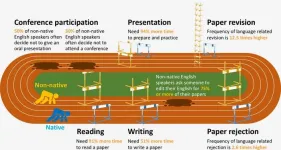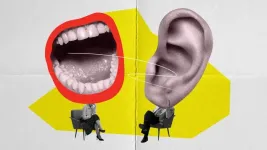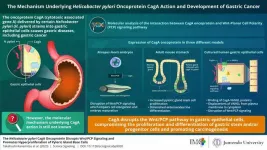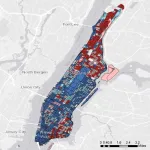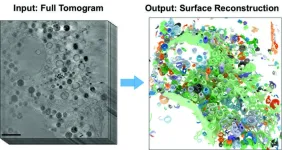(Press-News.org) Stanford engineers Michael Lepech and Zhiye Li have a unique vision of the future: buildings and roads made from plastic waste.
In a new white paper commissioned by the National Academies of Sciences, Engineering, and Medicine (NASEM), Lepech and Li study the current status, challenges, and needs of recycling plastics in a circular economy, and examine the long-term durability and environmental costs of doing so for use in infrastructure.
Using a mix of computer modeling, scientific research, experimental and field data, as well as interviews with recycling industry stakeholders, Lepech and Li analyze case studies using plastic waste for façade panels in the San Francisco Museum of Modern Art and pavement in a California Department of Transportation road project. Among other results, their findings indicate that recycled glass fiber reinforced polymer composite – a tensile plastic commonly used in car, boat, and plane parts – is a promising material for reuse in buildings.
NASEM will publish the white paper as an appendix to its annual report to Congress, the U.S. Department of Transportation, and the U.S. Environmental Protection Agency, and may use it as the basis of recommendations to policymakers.
Below, Lepech, a professor of civil and environmental engineering, and Li, a postdoctoral scholar in civil and environmental engineering, discuss obstacles, opportunities, and other aspects of transforming or upcycling plastic waste into valuable materials.
What are some of the biggest obstacles for repurposing plastic waste into infrastructure applications?
Lepech: One of the challenges that we and others identified through this work is the difficult economics and logistics of managing plastic waste streams from municipal solid waste. Plastic waste material flow is highly variable. Its mass can change from month to month, as can the type of plastic – lots of different packaging, for example.
What about the big opportunities?
Lepech: The recycling of entire buildings made of polymer composites at the end of their useful lives could be a game changer. That’s because the amount of material, along with its likely uniform composition, would make recycling it into another infrastructure application significantly easier.
Li: Our paper gives a few recommendations: Improve waste sorting, encourage and support plastic upcycling innovation, set up a performance database of certain plastic blends, and establish predictable models for these materials’ durability under different use conditions.
What lessons does upcycling of plastic waste for infrastructure hold for other circular economy efforts?
Li: Upcycling of recycled plastics in infrastructure sets an example of creating value by creating demand. The recycled plastic blended construction material needs to achieve certain performance requirements and maintain lower environmental impacts than conventional construction materials. Our paper shows that for a use case that has a longer lifespan – such as certain blended plastic composite building panels or asphalt pavement, the needed quality and sustainability requirements are more achievable.
Upcycling plastic waste has obvious environmental advantages. What are the business/profit advantages?
Lepech: Among the many potential advantages, firms that are part of a circular economy value chain may see regulatory advantages, such as extended protection of an explicit or implicit license to operate or greater flexibility with regulatory agencies. There are obvious operational efficiencies possible when not relying upon virgin fossil resources. From the standpoint of risk management, there could be reduced potential for environmental emergencies, such as oil spills, and reduced insurance premiums. There is certainly opportunity for growth by targeting markets that value environmentally friendly or sustainable products. Finally, firms can achieve increased clarity in strategic direction when they align value chains with corporate mission, especially in the case of environmentally conscious firms.
Beyond buildings and roadways, what are some major potential applications for upcycling plastic waste?
Li: Upcycling plastic waste in infrastructure has attracted increasing interest because it creates something of high value for which there is large potential demand. Beyond buildings, there are many applications for reusing plastic, but not many that would use as much plastic waste or last as long. For example, packaging consumes more than 60% of global recycled plastic, but has a short lifespan. Some automotive parts can be made with recycled plastic, but they require relatively little plastic to produce.
Lepech is also faculty director of the Stanford Center at the Incheon Global Campus, a research center in Korea focused on smart, sustainable cities and urban communities, and a senior fellow at the Stanford Woods Institute for the Environment. Li is also a researcher at Stanford’s John A. Blume Earthquake Engineering Center and the Stanford Center at the Incheon Global Campus.
- 30 -
END
MIAMI, FLORIDA (JULY 18, 2023) – Researchers from Sylvester Comprehensive Cancer Center at the University of Miami Miller School of Medicine and Dana Farber Cancer Institute in Boston have been awarded $7 million in total funding to study how diet and exercise impact mental and physical functioning in older cancer survivors and their caregivers.
The funding is being provided by the Patient-Centered Outcomes Research Institute (PCORI), a nonprofit, Washington, D.C.-based organization that supports research designed to help patients, caregivers and clinicians make better informed healthcare decisions.
Tracy ...
English serves as a convenient, common language for science. However, this practice poses insurmountable barriers to those whose first language is not English — the majority of people around the world. According to research published on July 18th in the open access journal PLOS Biology, led by Dr. Tatsuya Amano at the University of Queensland, Australia, the disadvantages of being a non-native English speaker in science range from difficulties in reading and writing papers to reduced participation in international conferences.
Few studies to date have ...
A “clear and significant” language barrier cost faced by non-native English-speaking scientists has been quantified by a University of Queensland-led international survey.
The study, led by UQ’s Dr Tatsuya Amano, surveyed 908 environmental science researchers on scientific activities across five categories – paper reading, writing, publication, dissemination, and conference participation – finding a substantial disadvantage for non-native English speakers in all five.
“Compared to native English speakers, non-native English speakers need up to twice as ...
Helicobacter pylori (H. pylori) infections are commonly associated with abdominal pain, bloating, and acidity. Clinical evidence suggests that infection with H. pylori cagA+ strains dramatically increases the risk of developing gastric cancer. A specialized protein delivered by H. pylori to the host, oncoprotein “CagA,” has been shown to interact with multiple host proteins and promote gastric carcinogenesis (transformation of normal cells to cancer cells). However, the underlying mechanisms associated with its biochemical activity have not been fully determined yet.
A new study published in Science Signaling on 18 July 2023 shares insights ...
TUSCALOOSA, Ala. – A fifth of neighborhood blocks in the continental United States most vulnerable to natural disaster account for a quarter of the lower 48 states’ risk, according to a detailed assessment of vulnerability.
Leaders in data-driven risk modeling, researchers at The University of Alabama used advanced data analysis and machine learning of more than 100 factors that influence vulnerability to natural hazards for about 11 million United States Census Bureau blocks, finding significant differences can exist between neighboring blocks.
The result published in the journal Nature Communications is the first mapping ...
INDIANAPOLIS—A new study led by Indiana University School of Medicine researchers shows primary care clinicians who receive specialized training can make accurate autism diagnoses for over 80 percent of young children referred with developmental delays, providing compelling evidence that community-based models of autism evaluation are a potential solution for improving access to this needed service. They recently published their findings in Pediatrics.
One in 36 children are now diagnosed with autism, according to the latest 2023 report from the Centers for Disease Control. In many regions of the county, waitlists ...
Vanderbilt University Medical Center has received a $7 million, five-year funding award from PCORI (Patient-Centered Outcomes Research Institute) to compare two sedatives used to place breathing tubes in the emergency department (ED) or intensive care unit (ICU).
To provide support with a breathing machine, doctors must place a breathing tube into a patient’s mouth and throat, and they are given a medication to make them sleep during this procedure. The two medications doctors most often give ...
Lewy body disease is the second most common neurodegenerative disease after Alzheimer's disease. A research group from Lund University has now shown that the disease can be detected before symptoms appear, using a spinal fluid test. The studies are published in Nature Medicine, where the researchers also demonstrate that reduced sense of smell is strongly linked to Lewy body disease even before other clear symptoms have developed. The findings are also reported simultaneously at the Alzheimer’s Association International Conference.
Lewy ...
The landmark United States Supreme Court ruling in Loving v. Commonwealth of Virginia abolished bans on interracial marriage in the United States in 1967, but a new academic paper from Rice University and Texas A&M University said an uptick in interracial relationships since then has not ended discriminatory tendencies, even among individuals who are in these romantic partnerships.
The paper, “Mixing races, maintaining racism? Considering the connection between interracial families, social distance and racial inequality,” is online and will appear in an upcoming edition ...
BESSY II's high-brilliance X-rays can be used to produce microscopic images with spatial resolution down to a few tens of nanometres. Whole cell volumes can be examined without the need for complex sample preparation as in electron microscopy. Under the X-ray microscope, the tiny cell organelles with their fine structures and boundary membranes appear clear and detailed, even in three dimensions. This makes cryo x-ray tomography ideal for studying changes in cell structures caused, for example, by external triggers. Until now, however, the evaluation of 3D tomograms has required largely manual and labour-intensive data ...

